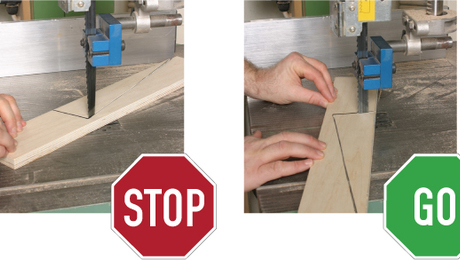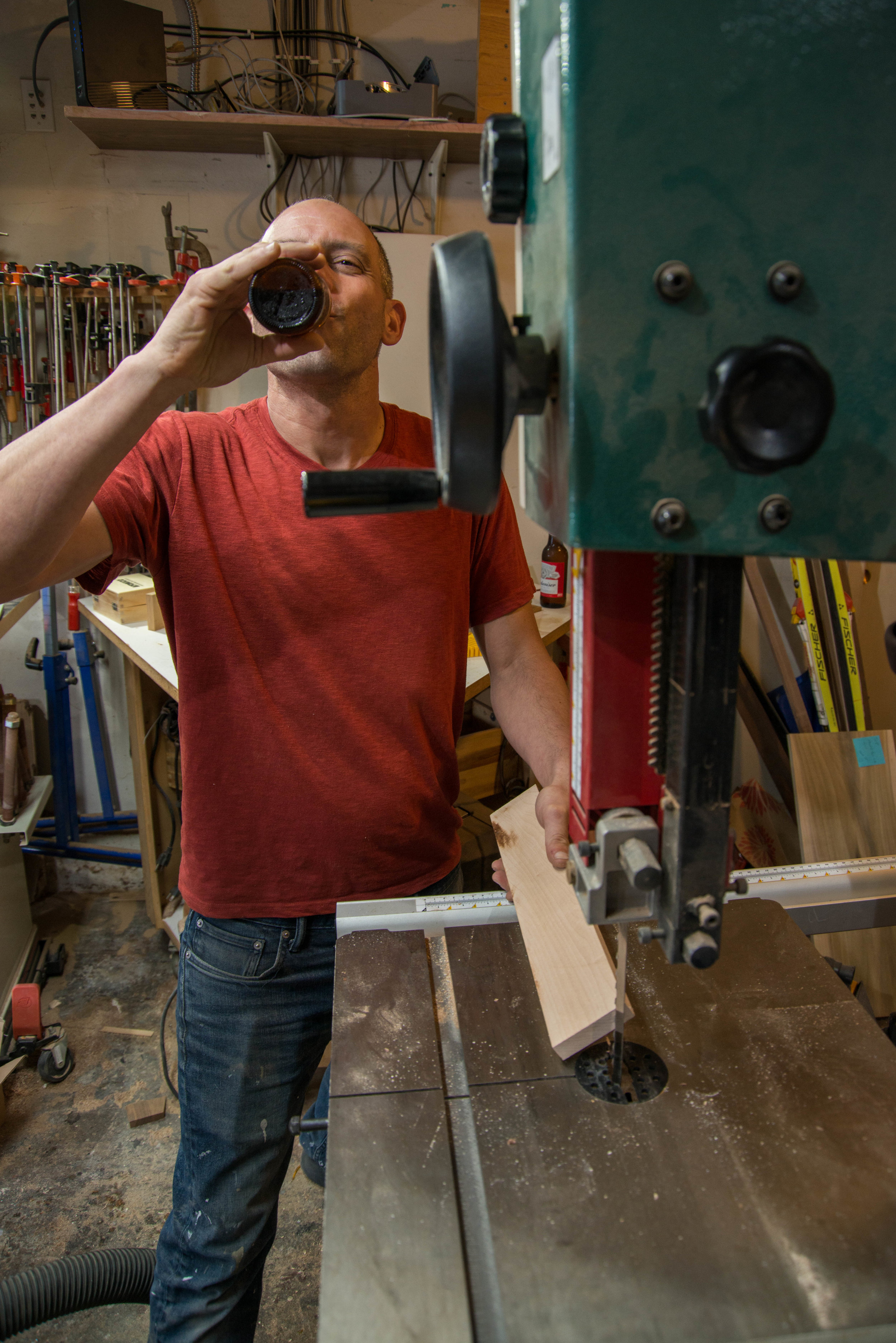If you’ve ever wondered “what not to do with a bandsaw?”, you’ve come to the right place! Bandsaws are powerful tools that can be incredibly useful, but they also come with their fair share of risks and potential dangers. In this article, we’ll explore some common mistakes to avoid when using a bandsaw, ensuring your safety and the longevity of your equipment.
A bandsaw can be a fantastic addition to your workshop, allowing you to make precise cuts in various materials. However, it’s essential to know what not to do when using this tool to prevent accidents and damage. By understanding these potential pitfalls, you can confidently handle a bandsaw and achieve excellent results while staying safe.
So, if you’re ready to delve into the world of bandsaws and learn what mistakes to steer clear of, let’s get started! Whether you’re a woodworking enthusiast or a hobbyist, this guide will provide valuable insights that can benefit beginners and experienced users alike. Let’s explore how to make the most of your bandsaw while avoiding common pitfalls along the way.

What Not to Do With a Bandsaw: Tips to Keep You Safe and Efficient
When it comes to using a bandsaw, there are certain things you should avoid to ensure your safety and the longevity of the tool. From improper maintenance to risky techniques, it’s important to be aware of what not to do with a bandsaw. In this article, we will explore seven key areas where mistakes can happen and provide valuable tips to prevent accidents and improve your productivity.
Using Dull or Damaged Blades: Why It’s a Big No-No
One of the most common mistakes people make when using a bandsaw is using dull or damaged blades. A dull blade not only hampers your productivity but also increases the chances of accidents. When a blade is dull, it requires more force to cut through materials, leading to instability and potential kickbacks. Similarly, damaged blades can break during operation, posing a serious risk to your safety.
To avoid these issues, make sure to regularly inspect and maintain your bandsaw blades. Invest in quality blades and replace them when they show signs of wear or damage. Keep spare blades on hand to avoid delays in your work and always use the appropriate blade for the material you’re cutting. Remember, a sharp and well-maintained blade ensures cleaner cuts, reduces strain on the machine, and keeps you safe.
Neglecting Proper Safety Gear: A Recipe for Disaster
Another critical mistake many people make when using a bandsaw is neglecting to wear proper safety gear. Bandsaws involve spinning blades that can cause serious injuries if mishandled. It’s essential to protect yourself by wearing the necessary safety equipment.
Always wear safety glasses to protect your eyes from flying debris, as well as ear protection to minimize the noise produced by the machine. Additionally, consider wearing gloves to maintain a firm grip on the material being cut and to protect your hands from accidental contact with the blade. Lastly, avoid loose clothing or jewelry that could get caught in the machine. Remember, safety should always be your top priority when using a bandsaw.
Forgetting to Secure the Workpiece: A Recipe for Disaster
A crucial aspect of using a bandsaw safely is properly securing the workpiece. Neglecting to do so can lead to accidents, such as the material being thrown off the machine or your hand slipping into the blade. Before you start cutting, make sure the workpiece is securely fastened in place using clamps or a vice.
If you’re working with smaller or irregularly shaped pieces, consider using a jig or a sled to hold them firmly in position. This will not only keep you safe but also ensure more accurate cuts. Remember, taking the time to secure the workpiece properly will save you from potential accidents and yield better results.
Incorrect Blade Tension: Finding the Sweet Spot
Proper blade tension is crucial for the smooth operation and longevity of your bandsaw. Many people make the mistake of either over-tightening or under-tightening the blade, which can lead to problems such as decreased cutting efficiency or excessive wear.
To find the sweet spot, start by adjusting the tension to the recommended level specified by the manufacturer. From there, make small adjustments and monitor the blade’s performance. The ideal tension will allow the blade to run smoothly and straight without bowing or wandering off track. If you notice any issues, make further adjustments until you achieve optimal performance. Remember, finding the right blade tension is essential for accurate cuts and preventing unnecessary strain on the machine.
Ignoring Proper Maintenance: A Recipe for Inefficiency and Malfunction
Maintaining your bandsaw is not just about blade care; it also involves regularly cleaning and lubricating the machine. Neglecting these maintenance tasks can lead to decreased efficiency, increased wear and tear, and even machine malfunction.
Start by cleaning the bandsaw after each use, removing any debris or sawdust that may have accumulated. Regularly check and clean the guide blocks, thrust bearings, and the drive belt. Lubricate the moving parts as recommended by the manufacturer to ensure smooth operation. Taking the time to properly maintain your bandsaw will not only extend its lifespan but also improve its performance and efficiency.
Key Takeaways: What Not to Do with a Bandsaw?
- Always wear safety goggles and gloves when using a bandsaw.
- Do not wear loose clothing or jewelry that could get caught in the machine.
- Never operate the bandsaw without proper training or supervision.
- Avoid using the bandsaw to cut materials that are too thick or hard for the blade.
- Do not attempt to adjust the blade tension or make any modifications without proper knowledge and guidance.
Frequently Asked Questions
When it comes to using a bandsaw, it’s important to know what mistakes to avoid in order to stay safe and get the best results. Here are some common questions regarding what not to do with a bandsaw.
1. How should I not position my hands while using a bandsaw?
When using a bandsaw, it’s crucial to keep your hands a safe distance away from the blade. Avoid placing your hands directly in line with the blade or near the cutting edge. Instead, use a push stick or a properly adjusted fence to guide the material through the saw, keeping your hands at a safe distance from the blade. This helps prevent accidental contact and potential injuries.
Additionally, never attempt to remove scraps or debris while the blade is still in motion. Wait for the blade to come to a complete stop before reaching into the cutting area to avoid any accidents or mishaps.
2. Can I use a bandsaw for materials it’s not designed for?
Using a bandsaw for materials it’s not designed for can lead to serious damage to the machine and compromise your safety. Avoid using the bandsaw for cutting materials that are too thick or dense, as this can put excessive strain on the blade and the motor. It’s important to refer to the manufacturer’s guidelines and determine the appropriate materials for your specific bandsaw model.
Attempting to force the bandsaw to cut materials it’s not meant for can also result in inaccurate cuts and a higher risk of kickback. Always use the right tool for the job to ensure both your safety and the quality of your work.
3. What should I not do when adjusting the bandsaw blade tension?
Adjusting the bandsaw blade tension is a crucial step in getting precise cuts. However, there are a few things you should avoid doing when making tension adjustments. First, do not overtighten the blade, as this can cause unnecessary stress on the blade and lead to premature wear or breakage. Follow the manufacturer’s recommendations for the appropriate blade tension for the specific type of material you are cutting.
Secondly, avoid adjusting the tension while the bandsaw is in motion. Make sure the machine is turned off and the blade has come to a complete stop before making any tension adjustments. This ensures your safety and allows for more accurate adjustments.
4. Why shouldn’t I use a dull blade on a bandsaw?
Using a dull blade on a bandsaw not only results in poor-quality cuts but also poses a greater risk of accidents. A dull blade requires more force to make cuts, which can lead to kickback and unexpected movement of the material. Additionally, a dull blade tends to wander off course, making it difficult to achieve precise cuts and ruining the material you’re working on.
Regularly inspect and replace a dull blade to maintain the highest level of safety and produce the best results. Sharpening or changing the blade when necessary ensures smoother cuts, reduces the chance of kickback, and prolongs the lifespan of your bandsaw.
5. What precautions should I take to avoid overheating the bandsaw motor?
Overheating the bandsaw motor can result in damage to the machine and compromise its performance. To avoid overheating, do not continuously cut for extended periods without giving the machine a break. Allow the motor to cool down between longer cutting sessions or use the machine intermittently for large projects.
Additionally, ensure that the bandsaw is properly lubricated. Friction between the blade and the material can generate heat, so regularly applying lubricant to the blade and keeping the saw well-maintained will help prevent overheating. Following these precautions will help extend the lifespan of your bandsaw and optimize its performance.

9 mistakes beginners make at the bandsaw. What to do instead.
Summary
So, here’s the deal: when it comes to using a bandsaw, there are a few things you should definitely NOT do. First off, never, ever remove the bandsaw guard. It’s there to protect you from the sharp blade, so keep it on at all times! Secondly, avoid wearing loose clothing or jewelry that can get caught in the machine. Safety always comes first, you know!
Another thing to avoid is forcing the wood through the blade. Let the bandsaw do the work, and don’t push too hard. Oh, and don’t forget to keep your fingers at a safe distance from the blade. You don’t want any accidents happening in the workshop! Lastly, always unplug the bandsaw before making any adjustments or changing the blade. Safety precautions should never be taken lightly.
To sum it up, remember to keep the guard on, be mindful of what you wear, let the machine do the work, keep your fingers away from the blade, and always unplug before tinkering. Stay safe and happy woodworking!
